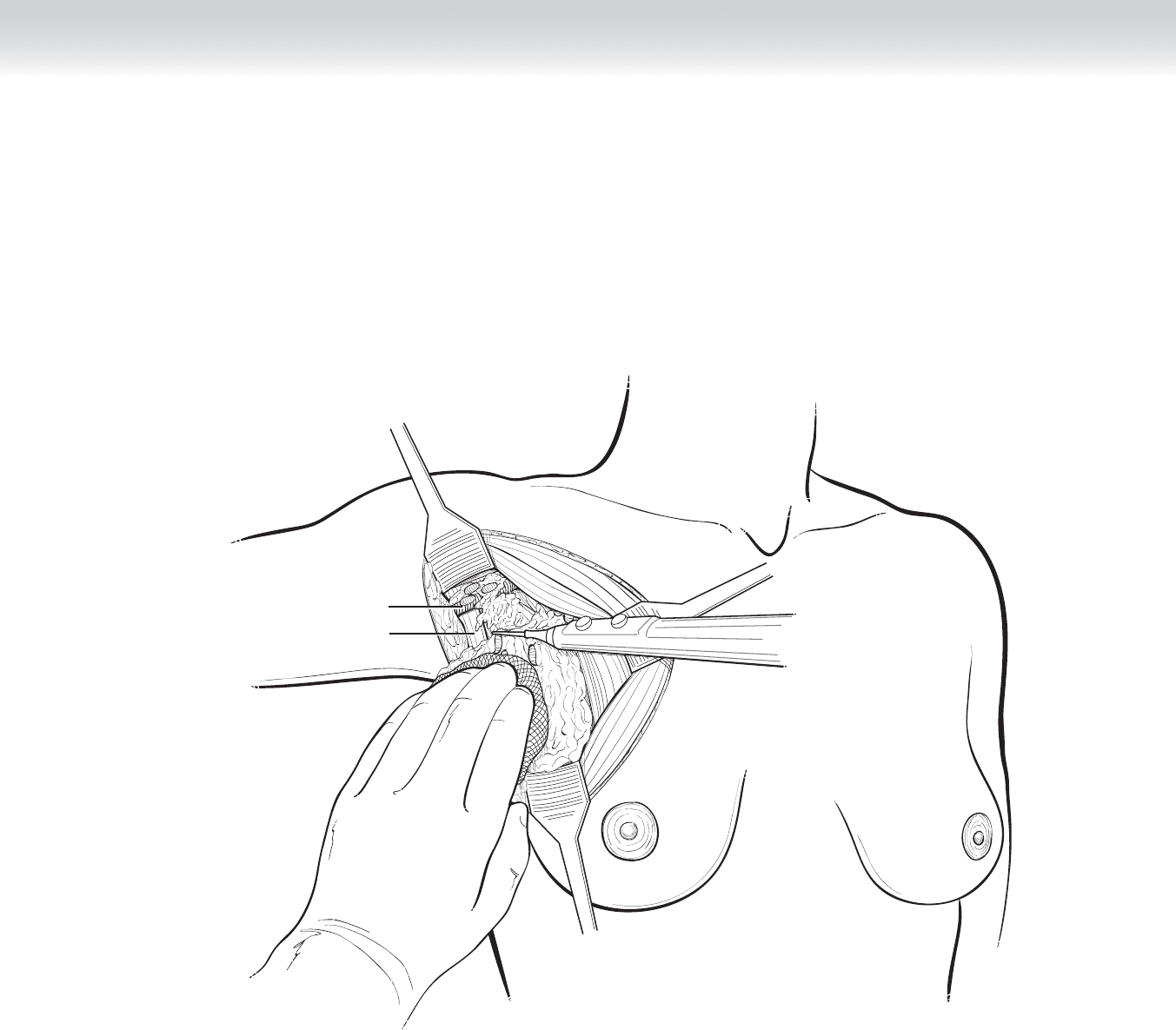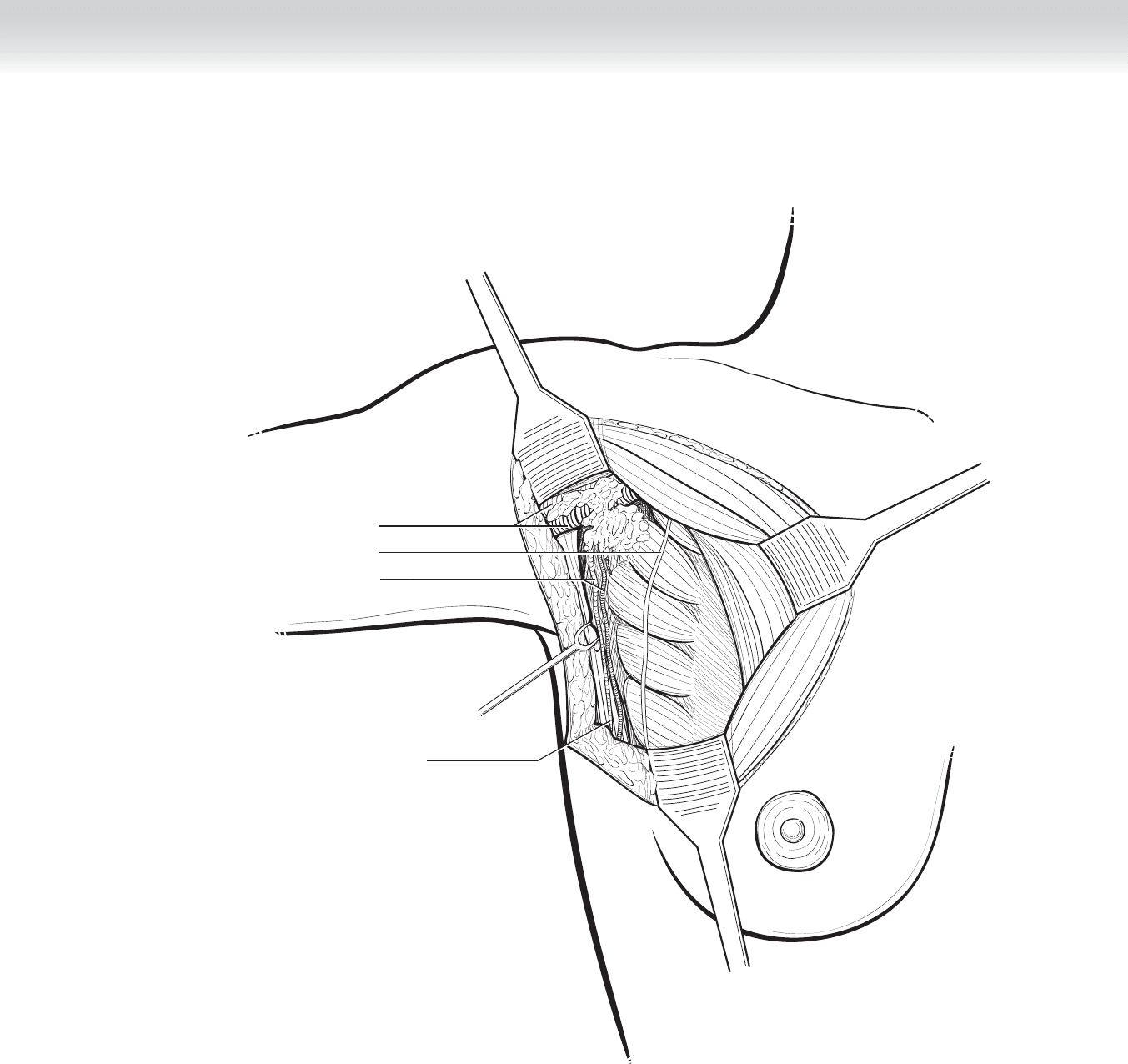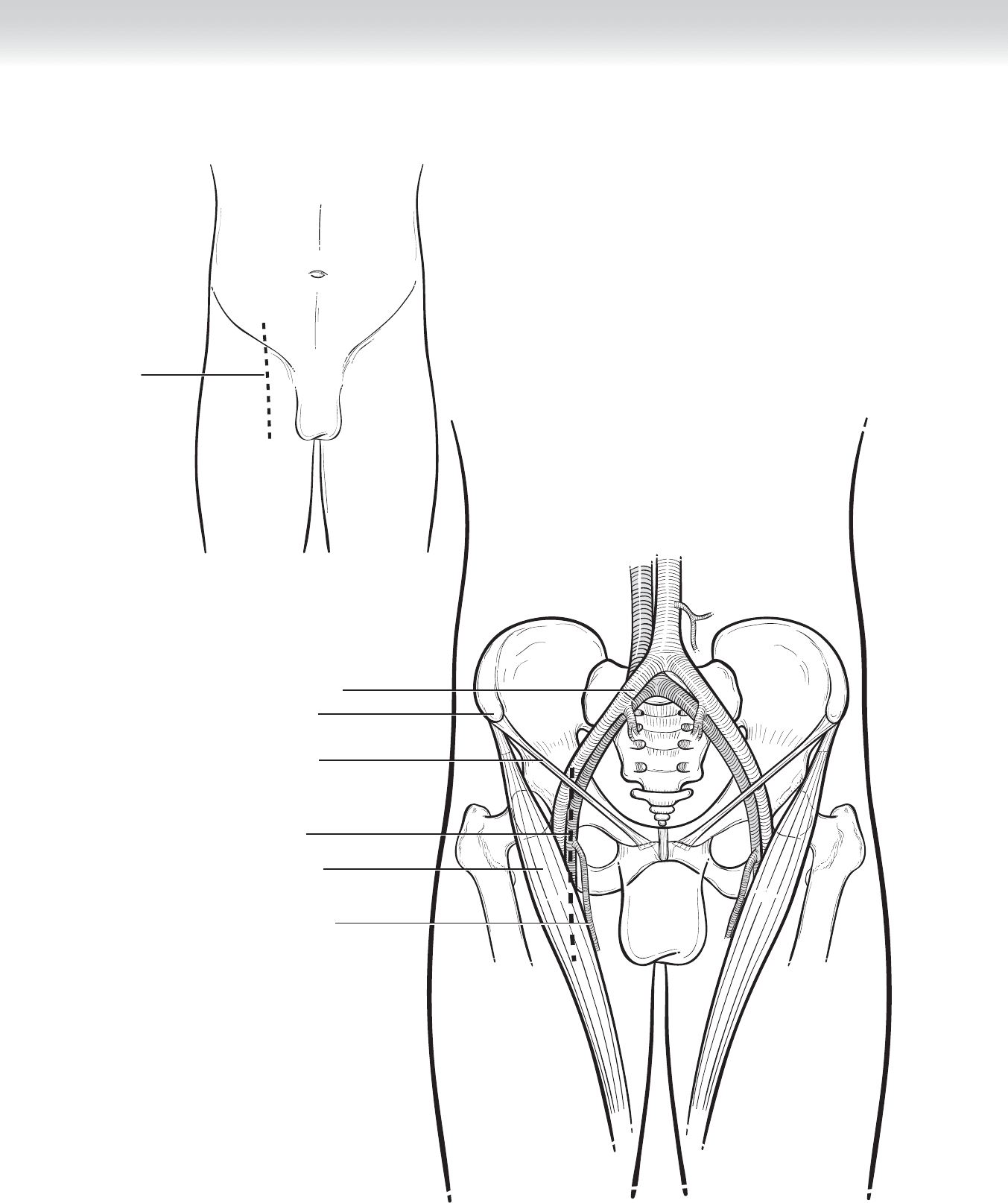Townsend Courtney M.Jr., Evers B. Mark. Atlas of General Surgical Techniques: Expert Consult
Подождите немного. Документ загружается.


CHAPTER 100 • Axillary Node Dissection 1115
Axillary vein
Latissimus dorsi muscle
FIGURE 100–4

1116 Section XV • Miscellaneous Procedures
◆ The thoracodorsal artery and vein with the thoracodorsal nerve medially will be identifi ed
in the lateral third of the axillary artery (Figure 100-5). The thoracodorsal trunk courses on
the medial aspect of the latissimus dorsi. Transection of the thoracodorsal nerve leads to
weakened shoulder adduction.
◆ Once the thoracodorsal trunk is identifi ed, lateral dissection is safe as long as the
intercostalbrachial cutaneous nerve is visualized as it emerges from the axillary fat pad
approximately halfway up the latissimus dorsi muscle, coursing toward the arm.
◆ The intercostalbrachial cutaneous nerve may be identifi ed coursing transversely below the
axillary vein and should be preserved if free of matted tumor-laden nodes to prevent
bothersome sensory dysesthesias along the medial aspect of the upper arm.
◆ Dissection medially should be cautious, with attention to the long thoracic nerve, which lies
on the serratus anterior muscle beneath the fascia (see Figure 100-5). Retraction of the
fascia off the chest wall will pull the long thoracic nerve off the chest wall and place it at
risk of injury. The nerve can be identifi ed deep to the intercostalbrachial nerve or higher,
inferior to the axillary vein on the chest wall, where it is less likely to have been pulled
away from the serratus anterior into the axillary fat. The nerve should be protected and
preserved. The function can be confi rmed by very gentle compression and demonstration of
contraction of the serratus muscle in the unparalyzed individual. Injury to the long thoracic
nerve causes a winged scapula.
◆ After the axillary boundaries and important structures are identifi ed, resection of the axil-
lary contents is carried out from superior to inferior, maintaining visualization of the nerves
at risk. As the fatty tissue is swept inferiorly, lymphatics and blood vessels are ligated or
clipped and transected.
◆ The axillary contents are oriented to identify the apex of the axilla.
◆ The axilla devoid of lymphatics and the chest wall are visualized (see Figure 100-5). The
cavity is irrigated with warm saline. Any residual bleeding vessels are cauterized or ligated.

CHAPTER 100 • Axillary Node Dissection 1117
Axillary artery and vein
Latissimus dorsi muscle
Long thoracic nerve
Thoracodorsal artery and vein
FIGURE 100–5

1118 Section XV • Miscellaneous Procedures
3. CLOSING
◆ A closed-suction drain, such as a 10-mm Jackson-Pratt drain, is inserted through a separate
small stab incision inferior laterally and oriented toward the apex of the axilla
(Figure 100-6). The drain is secured with a 2-0 silk suture.
◆ The skin is closed in two layers with absorbable sutures, a deep layer of 3-0 Vicryl and a
subcuticular closure with 4-0 Monocryl (see Figure 100-6). Steri-Strips or Dermabond may
be used for skin approximation. A light dressing or special mastectomy bra is applied with
loose fl uff gauze dressings.
Axillary drainage tube
FIGURE 100–6

CHAPTER 100 • Axillary Node Dissection 1119
STEP 4: POSTOPERATIVE CARE
◆ The drain is emptied 2 to 3 times per day, and drain output is recorded on a log.
◆ Drainage may be sanguinous immediately postoperatively but should be dilute.
◆ Continued postoperative frank bloody output indicates ongoing bleeding and warrants
return to the operating room.
◆ Drainage clears to serosanguinous, then clear and straw-colored.
◆ Cloudy fl uid may indicate bacterial infection and should be cultured.
◆ Drains are removed when the output is less than 30 mL for 2 consecutive days. Drains
usually remain for 7 to 10 days.
◆ Seroma may form after drain removal.
◆ Aspirate it in clinic if it is large, suspicious for infection, or uncomfortable.
◆ Multiple aspirations may be required.
◆ Compression dressing may reduce the likelihood of reaccumulation.
◆ Some seromas are reabsorbed without aspiration if they are small.
◆ Dressings are removed after 48 hours.
◆ Pain out of proportion to the procedure may indicate a signifi cant hematoma, for which
dressings should be removed sooner.
◆ Other indications include fever and excessive drainage.
◆ Taking a shower may be acceptable after 48 hours when dressings are removed.
◆ The surgical site is bathed with mild soap and water, patted dry, and re-dressed around
the drain site.
◆ The incision may be left open according to individual preference.
◆ Tub baths are usually not advised while drains are in place.
◆ Antibiotics are usually not needed but may be considered on an individual basis for the
following:
◆ Previous surgical biopsy
◆ Immunocompromised individuals
◆ Local wound conditions
◆ Limited exercises are initiated on postoperative day 1 and increased to range-of-motion and
strengthening exercises after the drains are removed.
◆ Consultation with American Cancer Society for Reach to Recovery is helpful.
◆ Consultation with occupational therapy for rehabilitation is useful.
◆ Individuals are monitored for lymphedema.

1120 Section XV • Miscellaneous Procedures
◆ Patient education about long-term precautions for protection of the affected extremity
include the following:
◆ Avoidance of blood pressure measurements and phlebotomy sticks on the affected extremity
◆ No intravenous infusion lines
◆ No constrictive clothing
◆ Use of electric razors for shaving
◆ Protective gloves for tasks that may lacerate the skin and lead to infection
◆ Early intervention with antibiotics for a hand or arm infection, often requiring
hospitalization for parenteral antibiotics
◆ Compression sleeve and glove may be indicated for cases of extensive nodal disease, combi-
nation surgery and radiotherapy, and evidence of lymphedema, as well as for prophylaxis
for air travel.
◆ Postoperative radiotherapy or chemotherapy is not initiated for 2 to 3 weeks.
◆ Scarring maybe reduced with application of a silicone sheet such as Biodermis.
STEP 5: PEARLS AND PITFALLS
◆ Discussion with the interdisciplinary team will sequence treatment in the most appropriate
manner.
◆ Preservation of the fascia of the serratus anterior muscle on the chest wall and identifi cation
of the long thoracic nerve underlying it on the chest wall will reduce the risk of transection
and the winged scapula deformity.
◆ Dissection along the lateral aspect of the latissimus dorsi muscle reduces the likelihood of
injury to the thoracodorsal trunk and weakened shoulder adduction.
◆ Preservation of the medial pectoral nerve prevents atrophy of the pectoralis major muscle
and chest wall contour.
◆ Preservation of the intercostal brachial cutaneous nerves maintains sensation to the medial
aspect of the upper extremity and prevents bothersome dysesthesias.
◆ Preservation of fatty tissue and lymphatic channels from the arm around the axillary vein
reduces the risk of lymphedema.
◆ In obese patients, anatomic boundaries may be more diffi cult to identify and require time
and patience during the procedure.
◆ The pulse in the axillary artery is a landmark that can help orient the surgeon to stay
inferior.

CHAPTER 100 • Axillary Node Dissection 1121
SELECTED REFERENCES
1. Fisher B, Anderson S, Bryant J, et al: Twenty-year follow-up of a randomized trial comparing total
mastectomy, lumpectomy, and lumpectomy plus irradiation for the treatment of invasive breast cancer.
N Engl J Med 2002;347:1233-1241.
2. Grube BJ, Rose CM, Giuliano AE: Local management of invasive breast cancer: Axilla. In Harris JR,
Lippman ME, Morrow M (eds): Diseases of the Breast. Philadelphia, Lippincott Williams & Wilkins,
2004, pp 745-784.
3. Iglehart JD, Kaelin CM: Diseases of the breast. In Townsend C Jr, Beauchamp R, Evers B, Mattox K (eds):
Sabiston Textbook of Surgery. Philadelphia, Elsevier Saunders, 2004, pp 867-927.
4. Lyman GH, Giuliano AE, Somerfi eld MR, et al: American Society of Clinical Oncology guideline recom-
mendations for sentinel lymph node biopsy in early-stage breast cancer. J Clin Oncol 2005;23:7703-7720.
5. Veronesi U, Cascinelli N, Mariani L, et al: Twenty-year follow-up of a randomized study comparing breast-
conserving surgery with radical mastectomy for early breast cancer. N Engl J Med 2002;347:1227-1232.

1122
STEP 1: SURGICAL ANATOMY
◆ The surgical anatomy of the groin is depicted in Figure 101-1.
STEP 2: PREOPERATIVE CONSIDERATIONS
◆ Accurate nodal staging may be accomplished by applying the techniques of sentinel lymph
node biopsy. The current recommendation for treatment of a histologically positive sentinel
lymph node is completion superfi cial inguinal node dissection. This operation is also indi-
cated for bulky groin disease, because this procedure is very effective treatment for local
disease control.
◆ Anesthesia: Either general anesthesia or epidural anesthesia may be used.
◆ Operative preparation: The patient is placed supine and prepared from 3 cm above the
umbilicus and groin, down to the ipsilateral toes and the perineum. The extremity is
prepped in its entirety and is externally rotated at the hip. A stack of sterile towels may be
placed behind the lateral aspect of the knee to facilitate a frog-leg position.
CHAPTER
101
Superfi cial Inguinal Node
Dissection
Celia Chao

CHAPTER 101 • Superfi cial Inguinal Node Dissection 1123
Great saphenous vein
Inguinal ligament
Anterior superior
iliac spine
Common iliac vessels
Line of incision
Sartorius muscle
FIGURE 101–2
Incision
FIGURE 101–1

1124 Section XV • Miscellaneous Procedures
STEP 3: OPERATIVE STEPS
1. INCISION
◆ A longitudinal incision (Figures 101-2 and 101-3) is made overlying the groin, incorporat-
ing any previous biopsy scars (such as that from a sentinel lymph node biopsy) with an
elliptical incision. Superiorly, the incision starts approximately 3 cm superior medial to the
anterior superior iliac spine, extends past the inguinal ligament, and ends at the femoral
triangle (the point at which the sartorius muscle crosses over the superfi cial femoral vessels;
see Figures 101-2 and 101-3). A scalpel is used to incise the skin down to dermis.
